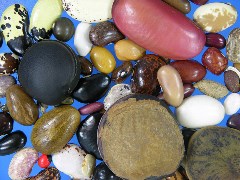Legumes - Annual meeting
|
Tropical Legumes I (TLI) Meeting Dates: 20–24 May 2013 Venue: Speke Resort and Conference Centre, Munyonyo, Kampala, Uganda
Incorporating the following meetings:
|
 |
|
Meeting documentation: |
Progress in 2010 - Groundnuts
Compilation of a database of phenotypic data of drought assessments from six locations (India, Niger, Mali, Senegal, Tanzania and Malawi) spanning six years, and statistical analysis of the same, was completed. Disease resistance was confirmed for some entries from Year 3 trials of Phase I. The reference collection was analysed for fodder quality traits in India, showing large variation in the germplasm. Analysis of lysimetric data generated in the past two-and-a-half years is almost complete. These data will enhance understanding of traits that are important for groundnut adaptation to intermittent drought. Excellent proof of concept has been obtained that higher disease resistance can be achieved by introgressing segments of the wild progenitors. Five F2:3 populations involving a stable source of early leaf spot (ELS) resistance were advanced to the next generation to produce F4 seed. These will be multiplied to produce F5 seed for phenotyping in the 2011 cropping season (June–September).
Progress in 2010 - Chickpeas
A total 20 prebreeding populations (five at EIAR, five at Egerton University, and 10 at ICRISAT–Kenya) were generated. Eight well-adapted and drought-tolerant lines from Ethiopia, Kenya and India have been selected for developing MAGIC populations, based on phenotypic variation. To make available a high-throughput and cost-effective SNP genotyping platform for at least 768 SNPs, the file of 2,002 genes containing SNPs were provided to KBioscience. For validating the KASPar assays, the DNA of 94 genotypes were also sent to KBioscience. The KASPar assays are anticipated to be available by the end of the first quarter of 2011.With supplementary funds from other partners, a genomewide physical map will be developed, over and above the previously planned identification of five candidate genomic regions for developing local physical maps. A proposal submitted to the Government of India Department of Biotechnology for funding for MABC and MARS research to enhance drought tolerance in chickpea was approved, with a total budget of about USD 1,037,000 over a period of three years.
Progress in 2010 - Cowpeas
Progress in 2010 - Beans
Ninety-five SNPs have been validated with KASPar technology, and a further 1,000 SNPs will be validated with Illumina technologies using the same parents. Towards achieving 200 breeding lines produced with combinations of bean common mosaic necrosis potyvirus (BCMNV), bruchid or common bacterial blight (CBB) resistance through appropriate genotyping methods, two populations were sent to Malawi for bean stem maggot phenotyping. A novel phenotyping method was tested, employing an infrared camera mounted on a mobile platform, and digital photographs, as opposed to static readings of a hand-held infrared ‘gun.’ This method permits rapid data collection of a large foliar area for subsequent analysis. Stomatal conductance, photosynthetic efficiency and water-use efficiency (through carbon isotope discrimination) were measured. Genotypic differences in agronomic water-use efficiency were also determined. Three inter-gene pool advanced backcross populations with more than 130 derived lines each are being advanced from F4 to F5, and could be ready for phenotyping in June 2011.


